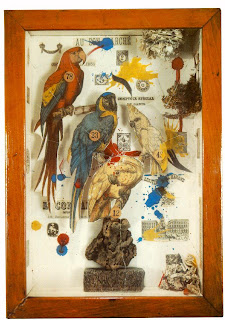Joseph Cornell (December 24, 1903 – December 29, 1972) was an American artist and sculptor, one of the pioneers and most celebrated exponents of assemblage. Influenced by the Surrealists, he was also an avant-garde experimental filmmaker.
Cornell's most characteristic art works were boxed assemblages created from found objects. These are simple boxes, usually glass-fronted, in which he arranged surprising collections of photographs or Victorian bric-à-brac, in a way that combines the formal austerity of Constructivism with the lively fantasy of Surrealism. Many of his boxes, such as the famous Medici Slot Machine boxes, are interactive and are meant to be handled.
Cornell often made boxed assemblages in series that reflected his various interests: the Soap Bubble Sets, the Medici Slot Machine series, the Pink Palace series, the Hotel series, the Observatory series, and the Space Object Boxes, among others. Also captivated with birds, Cornell created an Aviary series of boxes, in which colorful images of various birds were mounted on wood, cut out, & set against harsh white backgrounds.
link: Cornell Boxes
Article from Guggenheim Online Collection:
Joseph Cornell lived an isolated life with his mother at their home in Flushing, New York, from which he made frequent excursions into Manhattan to gather objects for his constructions. His diaries record his alternating feelings of being trapped at home, and then of release when he escaped to Manhattan. Working on his boxes at home in his cellar became a substitute for traveling, the arrangement of imaginary souvenirs inducing the excitement of voyages.
Fortune Telling Parrot offers many associations with exotic travels. First, the box construction itself resembles the apparatus of a hurdy-gurdy, invoking the bohemian world of the traveling gypsy musician. The crank on the right exterior of the construction turns a broken music box, hidden in the lower-right corner of the sculpture. The music box in turn is attached by a thin rod to the cylinder above it, which is intended to revolve while music plays.
The cylinder is covered with decorations, some of which suggest the paraphernalia and practices of the fortune-teller: playing cards such as the King of Hearts and the Jack of Clubs; the numbers one through nine; a picture of two hands playing cat’s cradle, recalling the entertainments of the gypsy; and the picture of a gypsy woman in elaborate costume. Small stars on the cylinder and a map of the constellation of Ursa Minor, “Little Bear,” in the lower-left corner of the box, also allude to astrology and divination. The parrot itself is a common attribute of the itinerant fortune-teller. Facing the revolving canister, this bird assumes the role of a soothsayer’s assistant. Exotic birds, including parrots, parakeets, and cockatoos, appear in some eighteen boxes by Cornell, the present example being the earliest and the others dating from the forties and fifties. In other boxes, birds are caged and chained on their perches, captured as exotic pets. Cornell recalls in his diary some of the experiences that contributed to his obsession with parrots: “magic windows of yesterday . . . pet shop windows splashed with white tropical plumage / the kind of revelation symptomatic of city wanderings in another era. . . . scintillating songs of Rossini and Bellini and the whole golden age of the bel canto . . . indelible childhood memory of an old German woman a neighbor’s pet parrot may have added to the obsession of these . . . feathered friends.”¹
Elizabeth C. Childs
1. Quoted in D. Ades, “The Transcendental Surrealism of Joseph Cornell,” in Joseph Cornell, exh. cat., New York, 1980, p. 37.
source: http://www.guggenheim.org/new-york/collections/collection-online/show-full/piece/?search=Fortune%20Telling%20Parrot%20(Parrot%20Music%20Box)&page=&f=Title&object=76.2553.126
Untitled (Cockatoo and Corks)
c. 1948; Construction, 14 3/8 x 13 1/2 x 5 5/8 in; Private collection
Untitled (The Hotel Eden)
c. 1945; Construction, 15 1/8 x 15 3/4 x 4 3/4 in; National Gallery of Canada, Ottawa
A Parrot for Juan Gris
Winter 1953-54; Construction, 17 3/4 x 12 3/16 x 4 5/8 in; Collection Paul Simon
Grand Hotel Semiramis
1950; Construction, 18 x 11 7/8 x 4 in; Private collection, New York
Untilted (Cockatoo with Watch Faces)
about 1949; Construction, 16 1/4 x 17 x 4 7/16 in; The Lindy and Edwin Bergman Collection, Chicago
Habitat Group for a Shooting Gallery
1943; Construction, 15 1/2 x 11 1/8 x 4 1/4 in; Des Moines Art Center, Coffin Fine Arts
The Caliph of Bagdad
about 1954; Construction 20.38 x 13.75 x 4.5 in
Aviary Parrot Box with Wire Drawers
1949; Construction 17.25 x 14 x 3.25 in
Fortune Telling Parrot (Parrot Music Box)
about 1937–38; Construction, 16 1/16 x 8 3/4 x 6 11/16, The Solomon R. Guggenheim Foundation, Venice
Untitled (Hôtel de la Duchesse-Anne)
1957; Construction 17 5/8 x 12 1/4 x 4 7/16 in; Lindy and Edwin Bergman Joseph Cornell Collection, Chicago
Untitled (Parrot and Butterfly Habitat)
about 1948; Construction 19.63 x 13.63 x 6.5 in; Kawamura Memorial Museum of Art, Sakura, Japan
Grand Hotel Fontaine (Bleu Parrot)
1950; Construction 16.75 x 10.25 x 4.63 in
Hotel De La Mer, about 1950
Joseph Cornell's boxes in a Simpson Episode














